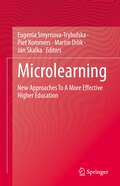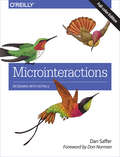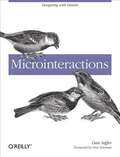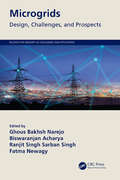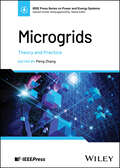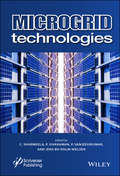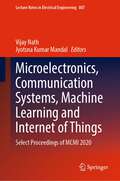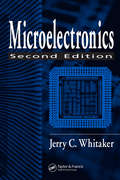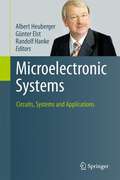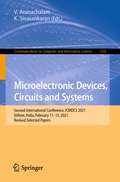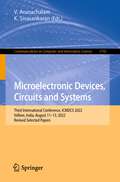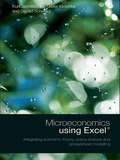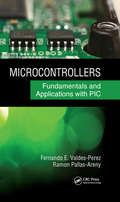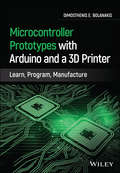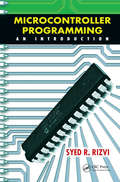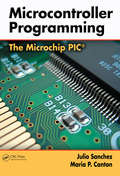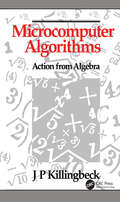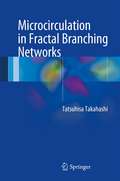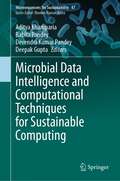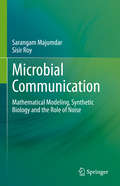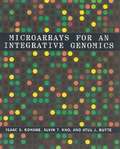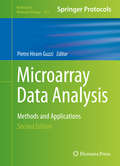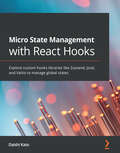- Table View
- List View
Microlearning: New Approaches To A More Effective Higher Education
by Eugenia Smyrnova-Trybulska Piet Kommers Martin Drlík Ján SkalkaThis book is about the most significant developments in the field of microlearning in the teaching of programming. In particular, the book covers the creation of content and the use of microlearning activities for automatically evaluating programming assignments. These critical component of microlearning represent a significant contribution both in fulfilling individual project objectives and in improving computer programming education in general. The book is interdisciplinary, examining both computer science and education. Specific topics explored include: development of distance courses, creating microcourses, fostering interdisciplinary knowledge, IT, management, and theoretical, methodological and practical aspects of the implementation of microlearning. Additionally, comprehensive analysis of the scientific literature (monographs, articles, proceedings) on the subject of the project and conducted research is provided.
Microinteractions: Designing with Details
by Dan SafferIt's the little things that turn a good digital product into a great one. With this full color practical book, you'll learn how to design effective microinteractions: the small details that exist inside and around features. How can users change a setting? How do they turn on mute, or know they have a new email message? Through vivid, real-world examples from today's devices and applications, author Dan Saffer walks you through a microinteraction's essential parts, then shows you how to use them in a mobile app, a web widget, and an appliance. You'll quickly discover how microinteractions can change a product from one that's tolerated into one that's treasured. Explore a microinteraction's structure: triggers, rules, feedback, modes, and loops Learn the types of triggers that initiate a microinteraction Create simple rules that define how your microinteraction can be used Help users understand the rules with feedback, using graphics, sounds, and vibrations Use modes to let users set preferences or modify a microinteraction Extend a microinteraction's life with loops, such as "Get data every 30 seconds"
Microinteractions
by Dan SafferIt's the little things that turn a good digital product into a great one. With this practical book, you'll learn how to design effective microinteractions: the small details that exist inside and around features. How can users change a setting? How do they turn on mute, or know they have a new email message? Through vivid, real-world examples from today's devices and applications, author Dan Saffer walks you through a microinteraction's essential parts, then shows you how to use them in a mobile app, a web widget, and an appliance. You'll quickly discover how microinteractions can change a product from one that's tolerated into one that's treasured. Explore a microinteraction's structure: triggers, rules, feedback, modes, and loops Learn the types of triggers that initiate a microinteraction Create simple rules that define how your microinteraction can be used Help users understand the rules with feedback, using graphics, sounds, and vibrations Use modes to let users set preferences or modify a microinteraction Extend a microinteraction's life with loops, such as "Get data every 30 seconds"
Microgrids: Design, Challenges, and Prospects (Big Data for Industry 4.0)
by Ghous Bakhsh Narejo Biswaranjan Acharya Ranjit Singh Sarban Singh Fatma NewagyThe book addresses the needs of researchers on the fundamentals as well as more advanced knowledge on microgrids and their evolution. This book covers newly emerging trends in fields such as Computer Science, Energy, Electrical Engineering, and Electronics and brings the reader up-to-date on the new emerging fields that play an important role in the power infrastructure. This book provides knowledge on decision making for newly evolving trends in microgrid design. It discusses techniques on how to improve the existing power quality and reduce load shedding and power imbalances. The book presents the emerging fields that now play an important role in microgrid design such as Data Science, Machine Learning, AI, and IT. The readership includes researchers, academia, practicing engineers, consumers, power companies and policy makers located across the globe.
Microgrids: Theory and Practice (IEEE Press Series on Power and Energy Systems)
by Peng ZhangMicrogrids Understand microgrids and networked microgrid systems Microgrids are interconnected groups of energy sources that operate together, capable of connecting with a larger grid or operating independently as needed and network conditions require. They can be valuable sources of energy for geographically circumscribed areas with highly targeted energy needs, and for remote or rural areas where continuous connection with a larger grid is difficult. Microgrids’ controllability makes them especially effective at incorporating renewable energy sources. Microgrids: Theory and Practice introduces readers to the analysis, design, and operation of microgrids and larger networked systems that integrate them. It brings to bear both cutting-edge research into microgrid technology and years of industry experience in designing and operating microgrids. Its discussions of core subjects such as microgrid modeling, control, and optimization make it an essential short treatment, valuable for both academic and industrial study. Readers will acquire the skills needed to address existing problems and meet new ones as this crucial area of power engineering develops. Microgrids: Theory and Practice also features: Incorporation of new cyber-physical system technologies for enabling microgrids as resiliency resources Theoretical treatment of a wide range of subjects including smart programmable microgrids, distributed and asynchronous optimization for microgrid dispatch, and AI-assisted microgrid protection Practical discussion of real-time microgrids simulations, hybrid microgrid design, transition to renewable microgrid networks, and more Microgrids: Theory and Practice is ideal as a textbook for graduate and advanced undergraduate courses in power engineering programs, and a valuable reference for power industry professionals looking to address the challenges posed by microgrids in their work.
Microgrid Technologies
by C. Sharmeela P. Sivaraman P. Sanjeevikumar Jens Bo Holm-NielsenMicrogrid technology is an emerging area, and it has numerous advantages over the conventional power grid. A microgrid is defined as Distributed Energy Resources (DER) and interconnected loads with clearly defined electrical boundaries that act as a single controllable entity concerning the grid. Microgrid technology enables the connection and disconnection of the system from the grid. That is, the microgrid can operate both in grid-connected and islanded modes of operation. Microgrid technologies are an important part of the evolving landscape of energy and power systems. Many aspects of microgrids are discussed in this volume, including, in the early chapters of the book, the various types of energy storage systems, power and energy management for microgrids, power electronics interface for AC & DC microgrids, battery management systems for microgrid applications, power system analysis for microgrids, and many others. The middle section of the book presents the power quality problems in microgrid systems and its mitigations, gives an overview of various power quality problems and its solutions, describes the PSO algorithm based UPQC controller for power quality enhancement, describes the power quality enhancement and grid support through a solar energy conversion system, presents the fuzzy logic-based power quality assessments, and covers various power quality indices. The final chapters in the book present the recent advancements in the microgrids, applications of Internet of Things (IoT) for microgrids, the application of artificial intelligent techniques, modeling of green energy smart meter for microgrids, communication networks for microgrids, and other aspects of microgrid technologies. Valuable as a learning tool for beginners in this area as well as a daily reference for engineers and scientists working in the area of microgrids, this is a must-have for any library.
Microelectronics, Communication Systems, Machine Learning and Internet of Things: Select Proceedings of MCMI 2020 (Lecture Notes in Electrical Engineering #887)
by Vijay Nath Jyotsna Kumar MandalThis volume presents peer-reviewed papers of the First International Conference on Microelectronics, Communication Systems, Machine Learning, and the Internet of Things (MCMI-2020). This book discusses recent trends in technology and advancement in microelectronics, nano-electronics, VLSI design, IC technologies, wireless communications, optical communications, SoC, advanced instrumentations, signal processing, internet of things, machine learning, image processing, green energy, hybrid vehicles, weather forecasting, cloud computing, renewable energy, CMOS sensors, actuators, RFID, transducers, real-time embedded system, sensor network and applications, EDA design tools and techniques, fuzzy logic & artificial intelligence, high-performance computer architecture, AI-based robotics & applications, brain-computer interface, deep learning, advanced operating systems, supply chain development & monitoring, physical systems design, ICT applications, e-farming, information security, etc. It includes original papers based on theoretical, practical, experimental, simulations, development, application, measurement, and testing. The applications and solutions discussed in the book will serve as good reference material for young scholars, researchers, and academics.
Microelectronics (Electronics Handbook Series)
by Jerry C. WhitakerWhen it comes to electronics, demand grows as technology shrinks. From consumer and industrial markets to military and aerospace applications, the call is for more functionality in smaller and smaller devices. Culled from the second edition of the best-selling Electronics Handbook, Microelectronics, Second Edition presents a summary of the current state of microelectronics and its innovative directions.This book focuses on the materials, devices, and applications of microelectronics technology. It details the IC design process and VLSI circuits, including gate arrays, programmable logic devices and arrays, parasitic capacitance, and transmission line delays. Coverage ranges from thermal properties and semiconductor materials to MOSFETs, digital logic families, memory devices, microprocessors, digital-to-analog and analog-to-digital converters, digital filters, and multichip module technology. Expert contributors discuss applications in machine vision, ad hoc networks, printing technologies, and data and optical storage systems. The book also includes defining terms, references, and suggestions for further reading. This edition features two new sections on fundamental properties and semiconductor devices.With updated material and references in every chapter, Microelectronics, Second Edition is an essential reference for work with microelectronics, electronics, circuits, systems, semiconductors, logic design, and microprocessors.
Microelectronic Systems
by Albert Heuberger Randolf Hanke Günter Elst Karlheinz Kirsch Janina HeppnerThis book is dedicated to Prof. Dr. Heinz Gerhäuser on the occasion of his retirement both from the position of Executive Director of the Fraunhofer Institute for Integrated Circuits IIS and from the Endowed Chair of Information Technologies with a Focus on Communication Electronics (LIKE) at the Friedrich-Alexander-Universität Erlangen-Nürnberg. Heinz Gerhäuser's vision and entrepreneurial spirit have made the Fraunhofer IIS one of the most successful and renowned German research institutions. He has been Director of the Fraunhofer IIS since 1993, and under his leadership it has grown to become the largest of Germany's 60 Fraunhofer Institutes, a position it retains to this day, currently employing over 730 staff. Likely his most important scientific as well as application-related contribution was his pivotal role in the development of the mp3 format, which would later become a worldwide success. The contributions to this Festschrift were written by both Fraunhofer IIS staff and external project team members in appreciation of Prof. Dr. Gerhäuser's lifetime academic achievements and his inspiring leadership at the Fraunhofer IIS. The papers reflect the broad spectrum of the institute's research activities and are grouped into sections on circuits, information systems, visual computing, and audio and multimedia. They provide academic and industrial researchers in fields like signal processing, sensor networks, microelectronics, and integrated circuits with an up-to-date overview of research results that have a huge potential for cutting-edge industrial applications.
Microelectronic Systems: Circuits, Systems and Applications
by Karlheinz Kirsch Janina HeppnerThis book is dedicated to Prof. Dr. Heinz Gerhäuser on the occasion of his retirement both from the position of Executive Director of the Fraunhofer Institute for Integrated Circuits IIS and from the Endowed Chair of Information Technologies with a Focus on Communication Electronics (LIKE) at the Friedrich-Alexander-Universität Erlangen-Nürnberg.Heinz Gerhäuser's vision and entrepreneurial spirit have made the Fraunhofer IIS one of the most successful and renowned German research institutions. He has been Director of the Fraunhofer IIS since 1993, and under his leadership it has grown to become the largest of Germany's 60 Fraunhofer Institutes, a position it retains to this day, currently employing over 730 staff. Likely his most important scientific as well as application-related contribution was his pivotal role in the development of the mp3 format, which would later become a worldwide success.The contributions to this Festschrift were written by both Fraunhofer IIS staff and external project team members in appreciation of Prof. Dr. Gerhäuser's lifetime academic achievements and his inspiring leadership at the Fraunhofer IIS. The papers reflect the broad spectrum of the institute's research activities and are grouped into sections on circuits, information systems, visual computing, and audio and multimedia. They provide academic and industrial researchers in fields like signal processing, sensor networks, microelectronics, and integrated circuits with an up-to-date overview of research results that have a huge potential for cutting-edge industrial applications.
Microelectronic Devices, Circuits and Systems: Second International Conference, ICMDCS 2021, Vellore, India, February 11-13, 2021, Revised Selected Papers (Communications in Computer and Information Science #1392)
by V. Arunachalam K. SivasankaranThis book constitutes selected papers from the Second International Conference on Microelectronic Devices, Circuits and Systems, ICMDCS 2021, held in Vellore, India, in February 2021. The 32 full papers and 6 short papers presented were thoroughly reviewed and selected from 103 submissions. They are organized in the topical sections on digital design for signal, image and video processing; VLSI testing and verification; emerging technologies and IoT; nano-scale modelling and process technology device; analog and mixed signal design; communication technologies and circuits; technology and modelling for micro electronic devices; electronics for green technology.
Microelectronic Devices, Circuits and Systems: Third International Conference, ICMDCS 2022, Vellore, India, August 11–13, 2022, Revised Selected Papers (Communications in Computer and Information Science #1743)
by V. Arunachalam K. SivasankaranThis book constitutes the proceedings of the Third International Conference on Microelectronic Devices, Circuits and Systems, ICMDCS 2022, was held in Vellore, India, in August 2022.The 9 full papers and 5 short paper presented in this volume were carefully reviewed and selected from 84 submissions. The papers are organized in the following topical sections: System Level Design; Digital Design; Analog, Mixed-Signal and RF Design; and Emerging Technologies.
Microeconomics using Excel: Integrating Economic Theory, Policy Analysis and Spreadsheet Modelling
by Gerald Schwarz Kurt Jechlitschka Dieter KirschkeUsing Microsoft Excel, the market leading spreadsheet package, this book combines theory with modelling aspects and spreadsheet analysis. Microeconomics Using Excel provides students with the tools with which to better understand microeconomic analysis.It focuses on solving microeconomic problems by integrating economic theory, policy analysis and
Microcontrollers: Fundamentals and Applications with PIC
by Fernando E. Valdes-Perez Ramon Pallas-ArenyMicrocontrollers exist in a wide variety of models with varying structures and numerous application opportunities. Despite this diversity, it is possible to find consistencies in the architecture of most microcontrollers. Microcontrollers: Fundamentals and Applications with PIC focuses on these common elements to describe the fundamentals of microcontroller design and programming. Using clear, concise language and a top-bottom approach, the book describes the parts that make up a microcontroller, how they work, and how they interact with each other. It also explains how to program medium-end PICs using assembler language. Examines analog as well as digital signals This volume describes the structure and resources of general microcontrollers as well as PIC microcontrollers, with a special focus on medium-end devices. The authors discuss memory organization and structure, and the assembler language used for programming medium-end PIC microcontrollers. They also explore how microcontrollers can acquire, process, and generate digital signals, explaining available techniques to deal with parallel input or output, peripherals, resources for real-time use, interrupts, and the specific characteristics of serial data interfaces in PIC microcontrollers. Finally, the book describes the acquisition and generation of analog signals either using resources inside the chip or by connecting peripheral circuits. Provides hands-on clarification Using practical examples and applications to supplement each topic, this volume provides the tools to thoroughly grasp the architecture and programming of microcontrollers. It avoids overly specific details so readers are quickly led toward design implementation. After mastering the material in this text, they will understand how to efficiently use PIC microcontrollers in a design process.
Microcontroller Prototypes with Arduino and a 3D Printer: Learn, Program, Manufacture
by Dimosthenis E. BolanakisDiscover a complete treatment of microcomputer programming and application development with Arduino and 3D printers Microcontroller Prototypes with Arduino and a 3D Printer: Learn, Program, Manufacture delivers a comprehensive guide to learning microcontrollers that’s perfectly suited to educators, researchers, and manufacturers. The book provides readers with a seasoned expert’s perspective on the process of microcomputer programming and application development. Carefully designed and written example code and explanatory figures accompany the text, helping the reader fully understand and retain the concepts described within. The book focuses on demonstrating how to craft creative and innovative solutions in embedded systems design by providing practical and illustrative methods and examples. An accompanying website includes functioning and tested source code and learning exercises and the book relies on freeware development tools for the creation of firmware and software code, 3D printed enclosures, and debugging. It allows the reader to work with modern sensors and collect sensor data to a host PC for offline analysis. Readers will also benefit from the inclusion of: A thorough introduction to the art of embedded computers, including their interdisciplinarity, TPACK analysis, and the impact of microcontroller technology on the maker industry An exploration of embedded programming with Arduino, including number representation and special-function codes and C common language reference A discussion of hardware interfaces with the outside world, including digital pin interface, analog pin interface, UART serial interface, I2C, and SPI A treatment of sensors and data acquisition, including environmental measurements with Arduino Uno, orientation and motion detection with Teensy, gesture recognition with TinyZero, and color sensing with Micro:bit A variety of supplementary resources – including source codes and examples - hosted on an accompanying website to be maintained by the author: www.mikroct.com. Perfect for researchers and undergraduate students in electrical and electronic engineering or computer engineering, Microcontroller Prototypes with Arduino and a 3D Printer: Learn, Program, Manufacture will also earn a place in the libraries of hardware engineers, embedded system designers, system engineers, and electronic engineers.
Microcontroller Programming: An Introduction
by Syed R. RizviMicrocontroller Programming: An Introduction is a comprehensive one-stop resource that covers the concepts, principles, solution development, and associated techniques involved in microcontroller-based systems. Focusing on the elements and features of the popular and powerful Motorola 68HC11 microcontroller IC as a representative example, this book
Microcontroller Programming: The Microchip PIC
by Julio Sanchez Maria P. CantonFrom cell phones and television remote controls to automobile engines and spacecraft, microcontrollers are everywhere. Programming these prolific devices is a much more involved and integrated task than it is for general-purpose microprocessors; microcontroller programmers must be fluent in application development, systems programming, and I/O operation as well as memory management and system timing. Using the popular and pervasive mid-range 8-bit Microchip PIC® as an archetype, Microcontroller Programming offers a self-contained presentation of the multidisciplinary tools needed to design and implement modern embedded systems and microcontrollers. The authors begin with basic electronics, number systems, and data concepts followed by digital logic, arithmetic, conversions, circuits, and circuit components to build a firm background in the computer science and electronics fundamentals involved in programming microcontrollers.For the remainder of the book, they focus on PIC architecture and programming tools and work systematically through programming various functions, modules, and devices. Helpful appendices supply the full mid-range PIC instruction set as well as additional programming solutions, a guide to resistor color codes, and a concise method for building custom circuit boards.Providing just the right mix of theory and practical guidance, Microcontroller Programming: The Microchip PIC® is the ideal tool for any amateur or professional designing and implementing stand-alone systems for a wide variety of applications.
Microcomputer Software Applications
by Joseph N. Roge Pamela T. Milstead Timothy Selwyn EllisInformation on using the DOS operating system, the WordPerfect editor, and the Quattro spreadsheet program.
Microcomputer Algorithms: Action from Algebra
by John KillingbeckAlthough the computing facilities available to scientists are becoming more powerful, the problems they are addressing are increasingly complex. The mathematical methods for simplifying the computing procedures are therefore as important as ever. Microcomputer Algorithms: Action from Algebra stresses the mathematical basis behind the use of many algorithms of computational mathematics, providing detailed descriptions on how to generate algorithms for a large number of different uses. Covering a wide range of mathematical and physical applications, the book contains the theory of 25 algorithms. The mathematical theory for each algorithm is described in detail prior to discussing the algorithm in full, with complete program listings. The book presents the algorithms in modular form, allowing for easy interpretation, for the adaptation to readers' specific requirements without difficulty, and for use with various microcomputers. Blending mathematics and programming in one volume, this book will be of broad interest to all scientists and engineers, particularly those physicists using microcomputers for scientific problem handling. Students handling numerical data for research projects will also find the book useful.
Microcirculation in Fractal Branching Networks
by Tatsuhisa TakahashiThis book presents a new method for analyzing the structure and function of the biological branching systems of fractal trees, with a focus on microcirculation. Branching systems in humans (vascular and bronchial trees) and those in the natural world (plants, trees, and rivers) are characterized by a fractal nature. To date, fractal studies have tended to concentrate on fractal dimensions, which quantify the complexity of objects, but the applications for practical use have remained largely unexplored. This book breaks new ground with topics that include the human retinal microcirculatory network, oxygen consumption by vascular walls, the Fåhraeus-Lindqvist effect, the bifurcation exponent, and the asymmetrical microvascular network. Readers are provided with simple formulas to express functions and a simulation graph with in vivo data. The book also discusses the mechanisms regulating blood flow and pressure and how they are related to pathological changes in the human body. Researchers and clinicians alike will find valuable new insights in these pioneering studies.
Microbial Data Intelligence and Computational Techniques for Sustainable Computing (Microorganisms for Sustainability #47)
by Aditya Khamparia Babita Pandey Devendra Kumar Pandey Deepak GuptaThis book offers information on intelligent and computational techniques for microbial data associated with plant microbes, human microbes etc. The main focus of this book is to provide an insight on building smart sustainable solutions for microbial technology using intelligent computational techniques. Microbes are ubiquitous in nature, and their interactions among each other are important for colonizing diverse habitats. The core idea of sustainable computing is to deploy algorithms, models, policies and protocols to improve energy efficiency and management of resources, enhancing ecological balance, biological sustenance and other services on societal contexts. Chapters in this book explore the conventional methods as well as the most recently recognized high-throughput technologies which are important for productive agroecosystems to feed the growing global population. This book is of interest to teachers, researchers, microbiologist, computer bioinformatics scientists,plant and environmental scientist, and those interested in environment stewardship around the world. The book also serves as an advanced textbook material for undergraduate and graduate students of computer science, biomedicine, agriculture, human science, forestry, ecology, soil science, and environmental sciences and policy makers.
Microbial Communication: Mathematical Modeling, Synthetic Biology and the Role of Noise
by Sarangam Majumdar Sisir RoyThis book introduces the concept of bacterial communication systems from a mathematical modeling point of view. It sheds light on the research undertaken in the last three decades, and the mathematical models that have been proposed to understand the underlying mechanism of such systems. These communication systems are related to quorum sensing mechanisms and quorum sensing regulated processes such as biofilm formation, gene expression, bioluminescence, swarming and virulence. The book further describes the phenomenon of noise, and discusses how noise plays a crucial role in gene expression and the quorum sensing circuit operationusing a set of tools like frequency domain analysis, power spectral density, stochastic simulation and the whitening effect. It also explores various aspects of synthetic biology (related to bacterial communication), such as genetic toggle switch, bistable gene regulatory networks, transcriptional repressor systems, pattern formation, synthetic cooperation, predator-prey synthetic systems, dynamical quorum sensing, synchronized quorum of genetic clocks, role of noise in synthetic biology, the Turing test and stochastic Turing test.
Microarrays for an Integrative Genomics
by Isaac S. Kohane Alvin Kho Atul J. ButteFunctional genomics--the deconstruction of the genome to determine the biological function of genes and gene interactions--is one of the most fruitful new areas of biology. The growing use of DNA microarrays allows researchers to assess the expression of tens of thousands of genes at a time. This quantitative change has led to qualitative progress in our ability to understand regulatory processes at the cellular level. This book provides a systematic introduction to the use of DNA microarrays as an investigative tool for functional genomics. The presentation is appropriate for readers from biology or bioinformatics. After presenting a framework for the design of microarray-driven functional genomics experiments, the book discusses the foundations for analyzing microarray data sets, genomic data-mining, the creation of standardized nomenclature and data models, clinical applications of functional genomics research, and the future of functional genomics.
Microarray Data Analysis
by Pietro Hiram GuzziThis volume covers a large area, from the description of methodologies for data analysis to the real application. Chapters focus on methodologies for preprocessing of microarray data, a survey of miRNA Data analysis, Cloud-based approaches, application of data mining techniques for data analysis, biclustering to query different datasets, web-based tool to analyze the evolution of miRNA clusters, application of biclustering to mine patterns of co-regulated genes ontologies, microarray and proteomic Data, Gene Regulatory Network Inference, Gene Regulatory Network methods, analysis of Mouse data for metabolomics studies, analysis of microRNA data in Multiple Myeloma, microarray data analysis in Gliobastomas, and microRNA data in Cardiogenesis. Written for the Methods in Molecular Biology series, chapters include introductions to their respective topics, lists of the necessary materials and reagents, step-by-step, readily reproducible laboratory protocols, and tips on troubleshooting and avoiding known pitfalls. Authoritative and practical, Microarray Data Analysis: Methods and Applications, Second Edition aims to ensure successful results in the further study of this vital field.
Micro State Management with React Hooks: Explore custom hooks libraries like Zustand, Jotai, and Valtio to manage global states
by Daishi KatoExplore global state management and select the best library for your applicationKey FeaturesUnderstand the essential concepts and features of micro state managementDiscover solutions to common problems faced while implementing micro state managementExplore the different libraries, their coding style, and the optimum approach to rendering optimizationBook DescriptionState management is one of the most complex concepts in React. Traditionally, developers have used monolithic state management solutions. Thanks to React Hooks, micro state management is something tuned for moving your application from a monolith to a microservice.This book provides a hands-on approach to the implementation of micro state management that will have you up and running and productive in no time. You'll learn basic patterns for state management in React and understand how to overcome the challenges encountered when you need to make the state global. Later chapters will show you how slicing a state into pieces is the way to overcome limitations. Using hooks, you'll see how you can easily reuse logic and have several solutions for specific domains, such as form state and server cache state. Finally, you'll explore how to use libraries such as Zustand, Jotai, and Valtio to organize state and manage development efficiently.By the end of this React book, you'll have learned how to choose the right global state management solution for your app requirement.What you will learnUnderstand micro state management and how you can deal with global stateBuild libraries using micro state management along with React HooksDiscover how micro approaches are easy using React HooksUnderstand the difference between component state and module stateExplore several approaches for implementing a global stateBecome well-versed with concrete examples and libraries such as Zustand, Jotai, and ValtioWho this book is forIf you're a React developer dealing with complex global state management solutions and want to learn how to choose the best alternative based on your requirements, this book is for you. Basic knowledge of JavaScript programming, React Hooks and TypeScript is assumed.
